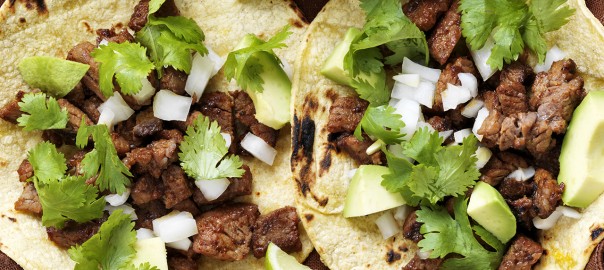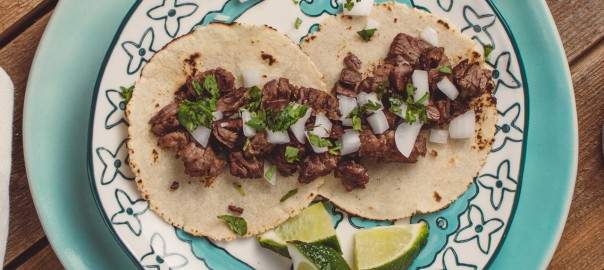Tacos.
You can never go wrong with tacos. And while in a former life I wouldn’t blink at “Making a Run for the Border” for a few late night beef, cheese, and lettuce treats. These days, there are too many good things happening with tacos to out there to even think about heading to the Taco Bell.
Not only are there a lot of Mexican restaurants concocting tacos with fantastic flavor combinations or perfecting the classic Mexican street taco, but there are also a plethora of amazingly delicious taco recipes out there these days that are quick, easy, and affordable.
For a truly splendid taco experience, you need to make them yourself. Skip the stovetop, skillet, and box of hard tortilla shells and seasoning mix, and throw lightly seasoned grass-fed flank steak on the grill, and thank us later.
There is no better time than summer to fire up the grill and make your carne asada tacos or grilled chicken tacos.
We even fully support cranking up the slow cooker for some al pastor or carnitas with a heritage breed pork butt. But, you don’t even need to do that. You can make both pork taco dishes on your grill as well.
Before we get into some great tactics for making the best grill tacos this summer, let’s quickly dig into how the delicious food became so popular in the first place.
Silver mines to street tacos to Tex-Mex
According to Jeffrey M. Pilcher, professor of history at the University of Minnesota and the author of the book Planet Taco: A Global History of Mexican Food, tacos as we know them today can be traced to the snacking habits of Mexican silver miners.
Pilcher explains in his book that, “People have been eating corn tortillas with bits of meat or beans rolled up inside for more than a millennium.” These corn-dough snack foods were known as antojitos and would come in many shapes with a variety of fillings.
The Spanish word taco was used for a “small bite of food” well before it can be found used in Mexico, according to Taco Planet. The term was also used for firearm plugs, among other things. At one point, “taco” was slang for gunpowder wrapped in paper used by silver miners outside of the town of Pachuca. It happened that these Mexican miners also preferred rolled tacos — and used that same term for both explosives and their packable lunches. Once the silver mining operations died down, they brought their rolled version of the dish to the streets of Mexico City, and then later to the American Southwest.
Tacos emerged in the American Southwest in the mid-twentieth century due to cultural intermingling and one particular food entrepreneur.
Mexican Americans living in the “borderlands” created various versions of tacos influenced by the mixing of cultures along the US-Mexico line. Tex-Mex, New Mexican, and Cal-Mex cuisines all had their own versions of the taco. Rolled tacos, for instance, are still popular at authentic Mexican restaurants in Southern California today.
While at a rolled taco shop in California in the 1960’s when hot dog vendor Glenn Bell realized he could quicken the pace of the methods used to make the long-cooking, fried rolled tacos. He realized he could do for the taco what McDonald’s did for the cheeseburger and opened his first taco shop in San Bernadino. Taking a relatively little-used preparation technique — the pre-fried, U-shaped, crispy corn tortilla shells — Bell’s restaurant, which eventually became Taco Bell, turned a Mexican food tradition into an American staple.
But the best tacos are grill tacos
There’s a bit of a food culture backlash against Glenn Bell’s crispy creation among taco aficionados. The days, the standard Mexican street taco — or at least a version of it with soft corn tortillas, barbacoa or carnitas, and a garnish of onions and cilantro — has become more prevalent at authentic Mexican restaurants, hole-in-the-wall Mom-and-Pop joints, street vendors, food trucks, and the like.
In his book on tacos, Jeffrey Pilcher even made a trek to Hermosillo, Mexico, to try the regions hard-to-find, traditional taco specialty, carne asada tacos. To make a point about “fast food,” he recounts the two minutes it took the husband and wife street cart vendors to grill their steak to perfection and fill it in warm tortillas with onions and cilantro. On his return to America, he compares his experience in Hermosillo with the two minutes it took the staff at a Los Angeles Taco Bell to nuke their take on the steak taco.
The best part of the move away from pre-mixed taco seasoning and ground beef tacos is that people now realize, just as Pilcher did, that it is as easy to make grill tacos in the far more delicious and fresh manner by cooking a lightly-seasoned steak on a grill or slow-cooking pork tacos.
We love all kinds of tacos, and we don’t think anyone can beat tacos with grilled grass-fed steaks, like flank steak or skirt steak, as well as free-range organic chicken breasts and heritage breed pork butt.
There is no comparison to marinating a steak overnight in some sweet and spicy marinade and throwing it on the grill, and then cutting it up, throwing it in some warm corn tortillas, and then adding some fresh radish or cabbage or cilantro. This dish is obviously best with some refried beans and an ice-cold Modelo.
We even found a recipe created by our friends at Traeger Grills that allows you to make al pastor tacos right on the grill.
But for all the recipes we love, few compare to Head ButcherBox Chef Yankel Polak’s delicious and easy NY strip steak tacos — grilled to perfection, sliced, and then mixed with a cabbage slaw.
Check it out one of the best taco recipes we’ve tried below:
Sweet and Sour NY Strip Tacos with Cabbage Slaw
Prep time: 15 minutes
Cook time: 15 minutes
Ingredients:
- 2 ButcherBox NY Strip Steaks
- Marinade and Slaw Dressing
- ¼ c sesame oil
- ¼ c honey
- ¼ c coconut aminos
- ¼ c rice vinegar
- 4 Tbsp sesame seeds
- Slaw
- 2 c shredded napa cabbage
- ½ c shredded carrots
- ½ c shredded Gala apple (any apple works!)
- salt and black pepper to taste
- 2 Tbsp fresh chopped cilantro (optional, for garnish)
Directions
1. Mix all marinade ingredients. Use ½ to marinate the steaks overnight, and reserve other ½ for the slaw.
2. Mix cabbage, apples, and carrots. Dress with marinade and refrigerate overnight for best flavor.
3. Preheat grill. If using an open flame, wait for flames to die down. Right before grilling, make sure grill surface is extremely hot, then rub it down with an oil-soaked rag – we advise using tongs to hold the rolled-up rag.
4. For medium-rare, place NY Strip Steak at 45° angle across hottest part of grill grates, then grill for 2 – 3 min per side, while rotating 90° every 1 ½ min. Move steak to the cooler part of the grill, then grill for 4 min per side. Keep your meat moving to ensure that it cooks evenly. Remove from grill when a meat thermometer inserted into thickest part reads 120°F.
5. Rest for at least 8 min. Slice thinly against the grain.
6. Serve steak topped with slaw in your favorite taco shell or sticky bun. Garnish with fresh cilantro and enjoy!





